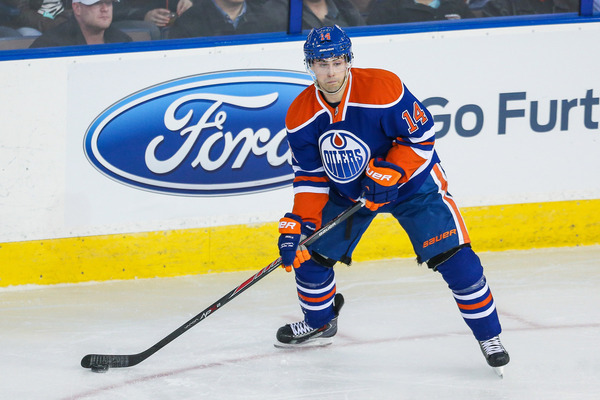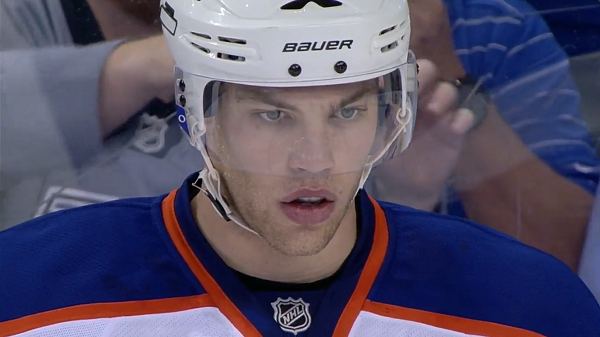The Leap of Faith: Ryan Johansen & Jordan Eberle

Negotiations between Columbus and star centre Ryan Johansen seem to have imploded rather badly. Blue Jackets’ management is publicly very frustrated, and on Wednesday went so far as to release publicly the three offers they had made to the RFA centre.
It’s an interesting negotiation to watch from an Oilers perspective, because Edmonton has gone a different direction with its young players – and has to make decisions on others in the future.
The Columbus Route
As I see it, the Blue Jackets’ decision to release those offers tells us two things:
- They’re hoping to rally fan support to their side
- They aren’t totally sure about Johansen
On the first point: these numbers look rich, and that’s going to bring fans onside – we all know the people who will interpret this as ‘That’s almost $50 million for a guy with one good year!’ There isn’t much upside to releasing these numbers except that it conveys to fans that the club is offering real money.
The dollars aren’t really that rich. A two-year deal at $3.0 million per is pretty clearly a win for the franchise; it’s a cheap bridge deal that will certainly deliver two years of value. The six year deal would buy two additional RFA years and two additional UFA years – and assuming that the Jackets value the first two seasons at $6.0 million total that puts a value of $6.5 million on those four years. Not bad if the team is getting two UFA seasons in that mix. The eight year deal is a bigger bargain, featuring two UFA years six seasons from now at $7.0 million per. Does anyone really believe that Johansen is going to be that cheap six years from now as an unrestricted free agent if he continues on last season’s path? Of course not.
The Blue Jackets don’t have much choice, though, because a long-term deal comes with significant risk. The team’s obvious desire for a bridge deal is probably more than just a club being cheap; they have good reason not to trust Johansen. As I noted in my Sportsnet piece a few weeks back, as recently as the spring of 2013 Johansen was a healthy scratch in the AHL and his phenomenal year this season involved a massive shooting percentage spike.
There’s a leap of faith involved in looking at a season like that; the Jackets don’t really want to take it.
The Edmonton Route

It seems obvious to compare Johansen to Taylor Hall and Ryan Nugent-Hopkins given draft position, but I don’t think that’s quite right – both Hall and Nugent-Hopkins were much more successful early than Johansen has been (despite the recent move by some in the media to retcon Nugent-Hopkins’ first year as a disaster).
The better comparison is to Jordan Eberle. He doesn’t have the draft pedigree of Johansen, but his early work was better and both had shooting percentage-driven jumps in their 21-year-old seasons. Eberle scored 34 goals and 76 points; Johansen scored 33 goals and 63 points. Edmonton promptly signed Eberle to a six-year, $36 million contract – despite the fact that he still had a year left on his entry-level contract. The deal bought four years of RFA eligibility and two years as a UFA at a cost $4.0 million greater than what the Jackets are offering Johansen on the same term.
I thought it represented an overpay at the time for a player in Eberle’s salary position – most RFA’s, especially then, didn’t get those deals, and I was convinced his 2011-12 campaign was an aberration. So far, though, it’s worked out alright because while the player’s scoring totals have fallen off he’s still averaged 28 goals and 65 points per 82 games played. Given his reputation there seems little question that the Oilers could trade him tomorrow for a handsome return if they wanted to do so; that ultimately shows what the market thinks of the contract. There is no question that those UFA years are worth more than $6.0 million per year, whatever Eberle’s RFA years are worth.
But the important thing here is the organizational philosophy involved. The Oilers decided to believe in Eberle and paid him accordingly. That’s what separates them from a Blue Jackets’ franchise offering $4.0 million less on a six-year deal to a player in a more valuable position (first line centre) and in an environment that has shifted more toward rewarding RFA’s.
Which is the right path?

It really depends on the player. For guys like Hall and Nugent-Hopkins, I think an early long-term deal is obviously the right move; these are players with elite-level potential.
For players like Eberle and Johansen, it’s more difficult and really depends on how the team in question values them. It’s vital to determine exactly what those guys are, where they project if all goes well and if all goes badly and the relative probabilities of each scenario.
If the team believes in the guy, sign him long-term. If the team doesn’t but others out there do, trade him; humans are risk-averse by nature but an NHL general manager needs to have the courage of his convictions and not be so concerned with covering his backside that he won’t take a risk. If the team doesn’t believe in the guy, and other teams’ trade offers indicate they don’t either, that’s the time to play hardball.
In the case of the Jackets and Johansen, it looks an awful lot like the team isn’t really sure of the player but is scared that they might be wrong, and has simultaneously low-balled the player while publicly refusing to even consider trading him. It’s weird.
RECENTLY BY JONATHAN WILLIS
- Bayesian training camp
- What Klefbom and Nurse need to do to crack the Oilers’ roster
- Jordan Oesterle is turning heads
- The coke machine prospect group
- Is the Edmonton market’s focus on prospects contributing to Oilers losses?
- Sean Monahan is more cautionary tale than guiding light for Leon Draisaitl
- Follow Jonathan Willis on Twitter
Recent articles from Jonathan Willis





